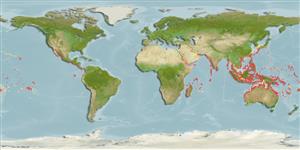Bivalvia |
Cardiida |
Tellinidae
Environment: milieu / climate zone / गहराई सीमा / distribution range
पारिस्थितिकी
; खारा; गहराई सीमा 0 - 30 m (संदर्भ 348). Tropical
Indo-Pacific: from East Africa, to eastern Polynesia; north to southern Japan and south to central Queensland.
Length at first maturity / आकार / Weight / Age
परिपक्व अवधि: Lm ? range ? - ? cm Max length : 8.5 cm SHL पुल्लिंग / अलिंग; (संदर्भ 348); common length : 5.0 cm SHL पुल्लिंग / अलिंग; (संदर्भ 348)
Found also in various environments such as open marine coasts or sheltered bays (Ref. 348).
Life cycle and mating behavior
परिपक्व अवधि | पुनरुत्पत्ति | मछलीऔ का अंडे देना | Eggs | Fecundity | Larvae
Members of the class Bivalvia are mostly gonochoric, some are protandric hermaphrodites. Life cycle: Embryos develop into free-swimming trocophore larvae, succeeded by the bivalve veliger, resembling a miniature clam.
Poutiers, J.M. 1998 Bivalves. Acephala, Lamellibranchia, Pelecypoda. p. 123-362. In Carpenter, K. E. and V. H. Niem. 1998. FAO species identification guide for fishery purposes. The living marine resources of the Western Central Pacific. Volume 1. Seaweeds, corals, bivalves, and gastropods. Rome, FAO. (संदर्भ 348)
IUCN Red List Status
(संदर्भ 130435: Version 2025-1)
CITES status (संदर्भ 108899)
Not Evaluated
CMS (संदर्भ 116361)
Not Evaluated
Threat to humans
Harmless
Human uses
मात्स्यिकी: व्यापारिक
| FishSource |
साधन
अधिक जानकारी
Trophic EcologyFood items (preys)
संघटक आहार
आहार खपत
परभक्षी
Population dynamicsबाढ़Max. ages / sizesLength-weight rel.Length-length rel.Length-frequenciesMass conversionबहुतायत Life cycleपुनरुत्पत्तिपरिपक्व अवधिFecundityमछलीऔ का अंडे देनाEggsEgg developmentLarvae PhysiologyOxygen consumption
Human RelatedStamps, coins, misc.
इंटरनेट स्रोत
Estimates based on models
Preferred temperature
(Ref.
115969): 24.5 - 29.3, mean 28.4 (based on 3437 cells).
Fishing Vulnerability
Low vulnerability (10 of 100).
Price category
Unknown.
